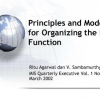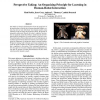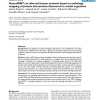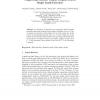954 search results - page 1 / 191 » Principles and Models for Organizing the IT Function |
MISQE
2002
13 years 7 months ago
2002
ARCS
2005
Springer
14 years 1 months ago
2005
Springer
In this contribution we present a novel general model for adaptive processors with organic features. We describe its basic principle of operation. The adaptive operations that are ...
AAAI
2006
13 years 9 months ago
2006
The ability to interpret demonstrations from the perspective of the teacher plays a critical role in human learning. Robotic systems that aim to learn effectively from human teach...
BMCBI
2005
13 years 7 months ago
2005
Background: The application of high throughput approaches to the identification of protein interactions has offered for the first time a glimpse of the global interactome of some ...
IEICET
2008
13 years 7 months ago
2008
In this paper, we introduce new compression function design principles supporting variable output lengths (multiples of size n). They are based on a function or block cipher with a...




